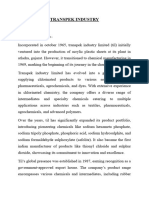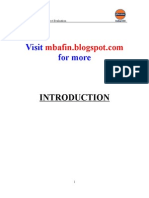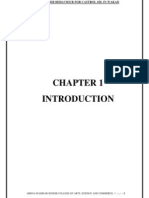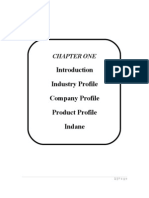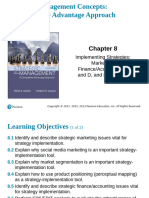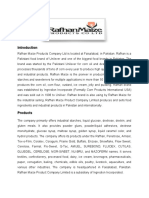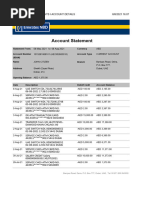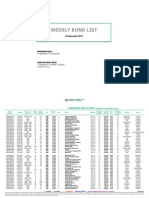IBM Term Project Final
IBM Term Project Final
Uploaded by
Prasanjeet DebCopyright:
Available Formats
IBM Term Project Final
IBM Term Project Final
Uploaded by
Prasanjeet DebOriginal Description:
Copyright
Available Formats
Share this document
Did you find this document useful?
Is this content inappropriate?
Copyright:
Available Formats
IBM Term Project Final
IBM Term Project Final
Uploaded by
Prasanjeet DebCopyright:
Available Formats
A
PROJECT REPORT ON
KIRLOSKAR BROTHERS LIMITED
Submitted To: - Submitted By:-
Prof. Raghuvir Singh Prasanjeet
Deb
Chaitnya Deshpande
Aman Saathi
TAPMI SCHOOL OF BUSINESS
Manipal University Jaipur
CHAPTER 1
ABOUT THE ORGANIZATON
1.1 Companys Registered Office
Kirloskar Brothers Limited is an Indian firm based in Pune, established in 1888
and incorporated in 1920, KBL is a flagship company of $ 2.5 billion Kirloskar
Group. The market leader in fluid management, KBL provides complete fluid
management solutions for large infrastructure projects in the areas of water
supply, power plants, irrigation, oil & gas and marine & defence. It
manufactures industrial, agriculture and domestic pumps, valves and hydro
turbines. The companys registered office address is
Kirloskar Brothers Limited
Udyog Bhawan, Tilak Road
Pune-411002 Maharashtra India.
Email: kblin@kbl.co.in
Website: www.kirloskarpumps.com, www.kbl.co.in
Group Website: www.kirloskar.com
The companys corporate office is located at
Kirloskar Brothers Limited
YAMUNA Survey No.98 (3-7), Baner
Pune411045, Maharashtra, India
1.2 Products Offered and Brand
Kirloskar Brothers Limited (KBL) is a world class pump manufacturing
company with expertise in engineering and manufacture of systems for fluid
management. Established in 1888 and incorporated in 1920, KBL is a flagship
company of the $2.1 billion Kirloskar Group. The market leader in fluid
management, KBL provides complete fluid management solutions for large
infrastructure projects in the areas of water supply, power plants, irrigation, oil
& gas and marine & defence. It manufactures industrial, agriculture and
domestic pumps, valves and hydro turbines.
In 2003, KBL acquired SPP pumps, UK and established SPP INC, Atlanta,
USA, is a wholly owned subsidiary of SPP, UKand expanded its international
presence. In 2007 Kirloskar Brothers International B.V., The Netherlands and
Kirloskar Brothers (Thailand) Ltd., a wholly owned subsidiary in Thailand were
incorporated. In 2008, KBL incorporated Kirloskar Brothers Europe B.V., a
joint venture between Kirloskar Brothers International BV and Industrial Pump
Group, The Netherlands. In 2010, KBL further consolidated its global position
by acquiring 90% stakes in Braybar Pumps, SA. SPP MENA was established in
Egypt in 2012. KBL has a joint venture corporation with Ebara, Japan since
1988. Kirloskar Corrocoat Private Ltd. Is a joint venture cooperation with
Corrocoat, UK since 2006. KBL acquired the Kolhapur Steel Limited in 2007
and Hematic Motors in 2010.
The company offers different kinds of products, which lies in the field of fluid
management. The products offered by KBL are:
Centrifugal Pumps
Valves
Motors
Alternators
Hydel Turbines
Turnkey Projects
Mobile Pump Controllers
There are no sub-brands of the company. Everything manufactured is sold under
the brand name of Kirloskar. There is no distinction between different kind of
products.
1.3 Products for Overseas Market
Pumps manufactured by Kirloskar in India are offered to overseas market with
power modification for certain countries with same pumps being offered in
domestic market. There are over 5000 types of pumps Kirloskar manufacturers.
It has divided its pump into 4 types
a) Agricultural Pumps:
b) Industrial Pumps
c) Domestic Pumps
d) Submersible Pumps
Within these divisions, the pumps are further classified into different types, viz.
Industrial segment is classified Fire pumps, Autoprime pumps, Oil and Energy
pumps. It has also differentiated its pumps by varying pip size, power
consumption and volume of water thrown per second to cater to the needs of
different customers. Kirloskar has divided all of its pumps into two different
categories:
a) MTS (Made To Sale): Those products which have demand in the market
and are fast moving. They are off the shelves within a month of reaching
the dealers.
b) MTO (Made To Order): Those pumps which are not in demand in the
market. A few customers require them, so they are manufactured as when
orders are placed by the customer. They are special pumps and generally
high-grade pumps.
Major Centrifugal pumps manufactured
Split-case pumps
Process pumps
Large Vertical Mixed flow pumps
Canned motor pumps
Metallic Volute pumps
Concrete Volute pumps
Primary / secondary moderator pumps for liquid sodium for fast
breeder reactor technology for Nuclear Power Plants
Kirloskar brothers limited has expanded itself globally by acquisitions of
different pump manufacturers across the globe. It has acquired UK based SPP
pumps in the year in the year 2003, Braybar pumps Limited in the year 2010
and Micwaber784 (pty) Limited in the year 2009, all of which were once the
most successful pump manufacturer in their respective countries. These
companies have their own set of pumps to be offered in different market to cater
to the needs of different customers.
1.4 Turnover
The revenue from operation of Kirloskar brothers limited is 17,516,340,754.
While from other sources the revenue generated is 54,616,152. The total
turnover of the company is about 1752 crore compared to 1872 crore in
previous year; a fall of 7% both in projects and product sector sales. Company
was selective with orders and execution made it improve sales mix. This
strategy resulted in increasing sale of manufactured product from 60% in 2012-
13 to 66% in the year 2013-14.
Exports Activities
The Company has achieved total exports of about ` 960 million.
The Company continues to receive orders from the American, Europe and
African countries for Water Supply Projects, Irrigation and Process
industries. Our efforts have led to establishing OE approvals and supplies to
many of the Globally, well known Engineering Procurement and
Construction (EPC) companies like Bechtel, UDHE, Danieli, Air Products
etc. Our focus has also increased on the neighbouring countries like Nepal,
Bhutan, Bangladesh, Myanmar, Vietnam and Sri Lanka for export of the
smaller range of pumps.
We continue our Focus Africa programme, embarking upon Food
Sufficiency Programme across Africa with innovative solutions for concept
to commissioning under our Triple A philosophy of Appropriate,
Adaptable & Affordable pumping solutions. Malawi and Zimbabwe are the
specific countries on our radar and work is in progress here.
In the ASEAN region our footprint has been increasing over the years and our
reach in the countries has strengthened. During the past year, our special focus
has been on Laos and Vietnam.
We are also pursuing Latin American markets. While the Company has been
successful in bagging repeat stock orders from specific countries from the
region, efforts are being made to spread its reach to other countries. We
consider Latin America of great importance for the quantum leap in our
export turnover.
Foreign exchange earnings and outgo
Earnings ` 1,183,501,806/-
Outgoing ` 932,906,519/-
1.5 Organization Structure
2. About the Companys Business (H)
No of countries operating
Kirloskar Brothers has a presence in over 80 countries. Selling
electrical equipment such water pumps.
What entry route it has taken in each country.
The company has taken the route to enter the countries through
providing water pumping solutions and electrical equipment to the
foreign market, which suits their needs and electrical norms
The company analyzed the foreign grounds before entering to look
for areas where it can setup the operation for good sales and
expansion. It further went into analysis of market for understanding
customer need and the price band based on economic performance
of the country.
It scanned for competition in the countries and established players,
which were a potential threat to Kirloskar Brothers Ltd. They
further analyzed the investment pattern and the capital required to
start up operations.
The entry route further depended on labor and channels for
distribution for movement of goods and pricing strategy.
The entry routes used across continents are:
a. Merger
b. Acquisition for manufacturing
c. Joint venture
d. Buy outs of smaller competition
e. Imports
Sales mostly to industries, wholesalers, agricultures and
households
Size of business in each country.
The size of business:
1. India: Market capital : 2,092 cr
Percentage of market share in India: 41%
2. Kenya
3. Mena
4. Egypt
Competitors of products in each country.
The competitors are of water pumps:
1. Crompton greaves
2. KSB
3. Dynamic
4. Shakti
5. Mather & Platt Pumps Ltd.
6. Roto Pumps Ltd.
7. WPIL Ltd.
How the Company has handled differences.
The company has handled different through various approaches
such as:
1. Capitalize on the competition
Turning competitors into clients. Not all of the competitors may
be targeting the same clients you do. By learning about the
competition. In return, sharing about your products and services
gives competitors an opportunity to refer your small business to
their clients.
2. Study larger companies.
A competitive business strategy that works across the board is
examining what other companies with more resources have
done in the past
What management approach the company uses.
The different management approaches are:
1. Human behavior approach
2. Decision theory approach
3. Management Science Approach
4. Systems approach
5. Operation approach
3. International Strategy(R)
Discuss how regional trade blocks have helped this company to remain
competitive ?
NO DATA AVAILABLE.
6. Has this Company any time executed world bank or any multilateral
sponsored projects. Please elaborate ?
Kirloskar brothers ltd. have never executed any project with world bank or any
multilateral sponsored projects.
7. What all currency areas the Company operates. Has it faced any
payment problems in the past. How the Company handles foreign
currency risk ?
Africa Currency
Kirloskar Brothers Limited (Egypt Branch Office)
SVC
SPP Pumps (MENA) LLC, Egypt SVC
Kirloskar Kenya Limited, Kenya KES
Braybar Pumps (Pty) Limited, South Africa ZAR
SPP PUMPS, South Africa ZAR
ASIA
Kirloskar Brothers Limited, Cambodia KHR
Kirloskar Brothers Limited China RO Office CNY
Kirloskar Brothers Limited, Indonesia IDR
Kirloskar Brothers Limited, Laos LAK
SPP PUMPS Limited, Singapore SD
Kirloskar Brothers (Thailand) Limited THB
Kirloskar Brothers (Thailand) Limited, Vietnam - RO Hanoi
EUROPE
SPP Pumps France, France EUR
Kirloskar Pompen BV, Nederlands EUR
SPP PUMPS Limited (UK Headquarters) GBP
MIDDLE EAST
SPP Pumps Limited, UAE SAR
SPP PUMPS, INC., USA USD
Kirloskar Brothers LLC, USA USD
There are no instances where the company went wrong in payment risks
experienced by Kirloskar Brothers Ltd.
Following study shows how foreign exchange risk is managed here in India.
KBL also follows these steps
Once a firm recognizes its exposure, it then has to deploy resources in managing
it. A heuristic for firms to manage this risk effectively is presented below which
can be modified to suit firm-specific needs i.e. some or all the following tools
could be used.
develop a forecast on the market trends and what the main direction/trend is
going to be on the foreign exchange rates. The period for forecasts is typically
6 months. It is important to base the forecasts on valid assumptions. Along with
identifying trends, a probability should be estimated for the forecast coming true
as well as how much the change would be.
actual profit or loss for a move in rates according to the forecast) and the
probability of this risk should be ascertained. The risk that a transaction would
fail due to market-specific problems4 should be taken into account. Finally, the
Systems Risk that can arise due to inadequacies such as reporting gaps and
implementation gaps in the firms exposure management system should be
estimated.
its limits for handling foreign exchange exposure. The firm also has to decide
whether to manage its exposures on a cost centre or profit centre basis.
A cost centre approach is a defensive one and the main aim is ensure that cash
flows of a firm are not adversely affected beyond a point. A profit centre
approach on the other hand is a more aggressive approach where the firm
decides to generate a net profit on its exposure over time.
firms then decides an appropriate hedging strategy. There are various financial
instruments available for the firm to choose from: futures, forwards, options and
swaps and issue of foreign debt. Hedging strategies and instruments are
explored n a section.
which are but estimates of reasonably unpredictable trends. It is imperative to
have stop loss arrangements in order to rescue the firm if the forecasts turn out
wrong. For this, there should be certain monitoring systems in place to detect
critical levels in the foreign exchange rates for appropriate measure to be taken.
review based on periodic reporting. The reports mainly include profit/ loss
status on open contracts after marking to market, the actual exchange/ interest
rate achieved on each exposure, and profitability vis--vis the benchmark and
the expected changes in overall exposure due to forecasted exchange/ interest
rate movements. The review analyses whether the benchmarks set are valid
Based on inputs from Kshitij Consultancy Services
For example, the foreign exchange market of a developing country may be
highly regulated and thus exposed to sudden swings due to frequent policy
changes.
Corporate Hedging for Foreign Exchange Risk and effective in controlling the
exposures, what the market trends are andfinally whether the overall strategy is
working or needs change.
8. Product Decision in International Markets.
Product line offered in each market.
- Following are the products offered by KBL
Pumps
Engines
Compressors
Chillers
Valves
Pig Iron
Construction
Transmissions
Automobiles Through A Joint Venture With Toyota
Infrastructure Pumping Projects
Bridges & Flyovers
Submarine Pipelines
Construction
Tax Concessions
State cabinet minister V.S. Acharya said The cabinet has decided
to give Rs 9 crore tax relief to the Toyota joint venture on import
of tools and machinery valued at Rs 450 crore. With this,
cumulative tax concessions extended to the company during the
last two years will be Rs 89 crore, He also said Toyota has
committed to invest Rs.4,043 crore in its second plant to
manufacture Etios car in hatchback and sedan versions, with an
installed capacity of 70,000 units per annum,
Pricing Methods:
Cost-plus pricing - Set the price at your production cost, including
both cost of goods and fixed costs at your current volume, plus a
certain profit margin
Target return pricing - Set your price to achieve a target return-
on-investment (ROI)
Value-based pricing - Price your product based on the value it
creates for the customer
Psychological pricing - Ultimately, you must take into
consideration the consumer's perception of your price
Positioning - If you want to be the "low-cost leader", you must be
priced lower than your competition
Popular price points - There are certain "price points" (specific
prices) at which people become much more willing to buy a certain
type of product
Fair pricing - Sometimes it simply doesn't matter what the value
of the product is, even if you don't have any direct competition
10. Advertising and Promotions
(i) Change in advertising strategy from one country to another
No marketing strategy is intended to be unchangeable or evergreen. In
fact, marketers recognize that each element of the strategy reflects current
circumstances that are almost certain to evolve over time. Among the
circumstances most likely to trigger strategic change are new characteristics of
the target market, technological advances, competition and a change in the
organization's mission.
Various countries have various factors which influence the purchasing
decision of the customer. Accordingly, companies have to modify their
advertising startegies in order to focus on the target customer.
For connection with the local market, kirloskars always tried to use the local
language for the advertising purpose. Music backgrounds used were specific to
the nation where it was aired.
Source : Youtube.com
(ii) Comparison of media cost among nations (at least 3 countries)
11. HR Strategy (H)
(i) Compensation policy
Kept confidential
(ii) Recruitment source & strategy.
The company follows a strategy of recruiting number as the need arises for
dedicated projects and client requirement, at higher positions it is usually filled
through succession planning or external sourcing, whichever suits the best
possible answer for the situation.
The sources for recruitment are:
1. Fresher/Graduate/Engineer
1. Campus placements
2. External agencies
3. Advertisements
4. Invitations
Strategy: To attain fresh blood with innovative ideas and self-motivated to
move through tasks quickly and obtain desired results with utmost quality and
precisely
2. Candidates with Experience
1. Internal Sourcing
2. Referrals
3. Promotions
Strategy: To fulfill the positions using internal employees or source employees
from referral to ensure employee commitment by generating sense of
involvement in employee joining and promotion indicating excel in work done.
Also, the external sourcing is performed to fulfill the position in case no eligible
candidacy is found.
(iii) Training & Development of employee.
The training of employees are done to impart new skillsets and help them
pipeline the skills to use of the benefit if the organizational.
Development is imparted to managers to enable them to improve the current
skills to match the changing market dynamics.
The different techniques are:
1. On the job training
2. Vestibule training
3. Class room training
4. Internship
(iv) Employee Engagement
Employee engagement is a property of the relationship between an organization
and its employees. An "engaged employee" is one who is fully absorbed by and
enthusiastic about their work and so takes positive action to further the
organization's reputation and interests.
Therefore Kirloskar takes the appropriate actions to check the engagement of
employees and constantly check the work done by them and ensure proper job
matching. The people is unsatisfied or un engaged is reassigned to the most
appropriate role in order to keep him working and firm to attain the maximum
efficiency.
(v) Employee retention
Employee retention refers to the ability of an organization to retain the
employees.
In a business setting, the goal of employers is usually to decrease employee
turnover, thereby decreasing training costs, recruitment costs and loss of talent
and organizational knowledge. By implementing lessons learned from key
organizational behavior concepts employers can improve retention rates and
decrease the associated costs of high turnover. However, this isn't always the
case. Employers can seek "positive turnover" whereby they aim to maintain
only those employees who they consider to be high performers.
Different techniques used are:
1. Focus on people development
2. Participation in management
3. Working conditions
4. Rewards and recognition given to the executives
5. Satisfaction with compensation level
Finance Strategy
(i) Source of funds
Equity Share:
Particulars
Figures as at the
end of current
reporting period
ending on
March 31, 2014
Figures as at the
end of previous
reporting period
ending on
March 31, 2013
Share Capital
Authorised
250,000,000 ) equity shares of 250,000,000 ( ` 2/- each ( ` 2 /-) each 500,000,000 500,000,000
Issued, subscribed & fully paid up
,358,451 (79,358,451) equity shares of 79 ` ( /- each 2 ` /-) each 2 158,716,902 158,716,902
TOTAL 158,716,902 158,716,902
a) Reconciliation of share capital
Particulars
Figures as at the end of
current reporting period
ending on March 31, 2014
Figures as at the end of
previous reporting period
ending on March 31, 2013
Number ` Number `
Shares outstanding at the beginning of the year 79,358,451
158,716,902
158,679,402 79,339,701
Shares Issued during the year under ESOS - - 18,750 37,500
Shares outstanding at the end of the year 79,358,451 158,716,902
79,358,451 158,716,902
RESERVES & SURPLUS
LONG TERM BORROWING
Particulars
Figures as at the end
of current reporting
period ending on
March 31, 2014
Figures as at the end of
previous reporting
period ending on
March 31, 2013
Note : A-2
Reserves & Surplus
Capital Reserves ) a ( 172,443 172,443
4,000,000 Capital Redemption Reserve ) b ( 4,000,000
) ( c Securities Premium Reserve
Opening balance 406,726,159 403,910,847
Add : Securities premium credited on share issue - 2,815,312
Closing balance 406,726,159 406,726,159
) d ( Share Options Outstanding Account
Opening balance ,394,856 35 40,138,248
Less : Written back in current year 31,284,441 4,743,392
Closing balance 4 ,110,415 35,394,856
( e ) General Reserve
Opening balance 5,731,453,426 5,688,005,700
Add : Transfer from Surplus 47,687,495 43,447,726
Closing balance 5,779,140,921 5,731,453,426
f
Surplus ) (
Opening balance 1,449,112,037 1,241,391,915
Add : Net Profit for the current year 476,874,945 434,477,258
Balance available for appropriation 1,925,986,982 1,675,869,173
Less : Appropriations
Proposed dividend 198,396,128 158,716,902
Dividend distribution tax 32,132,101 24,592,508
Transfer to general reserve 47 ,687,495 43,447,726
278,215,724
226,757,136
Closing balance 1,647,771,258 1,449,112,037
TOTAL 7,841,921,196 7,626,858,921
`
SHORT TERM LOAN
(ii) Profitability at each location
Amidst focus to ensure profitable growth with improvement in cash availability,
KBL has taken a conscious decision of being selective in accepting project and
product orders which will ensure positive cash flow and result in targeted
profitability. It has decided to focus more on the promotion of its manufactured
products to get higher profitability. The payment terms have been changed to
ensure better cash flow. The initiatives will help in reducing inventory and
borrowings thereby enhancing better management of working capital, reduction
in interest cost & higher profit margins. Introduction of new products with
differentiated value proposition for the customers are being promoted. This has
started reaping benefits in terms of increased profit driven sales with good cash
flow. KBL plans to strengthen its customer relationship management process to
provide world class after sales support with service & spares.
With all these initiatives we expect its consolidated revenue mix for its product
business to grow substantially from 69% to 80% by FY14 & ultimately its
contribution from its project business will reduce to a bare minimum by FY15
& selective bidding will be made for orders with good payment terms (~90%
payment term in first year itself) which are profitable & cash positive
throughout its execution period.
The profit of the company in FY 13-14 in India was 476,874,945 while in the
same year the total profit of company from foreign market was Euro 4,699,797.
(iii) Cost of funds
The interest rate paid by financial institutions for the funds that they deploy in
their business. The cost of funds is one of the most important input costs for a
financial institution, since a lower cost will generate better returns when the
funds are deployed in the form of short-term and long-term loans to borrowers.
The spread between the cost of funds and the interest rate charged to borrowers
represents one of the main sources of profit for most financial institutions.
A cost of funds index or COFI is a regional average of interest expenses
incurred by financial institutions, which in turn is used as a base for
calculating variable rate loans. The interest rate on an adjustable rate mortgage,
for example, is often linked to a regional COFI specified in the particular loan
documents. COFIs, in turn, are usually calculated by a self-regulatory agency
like Federal Home Loan Banks. In California, for example, many
home mortgage loans are indexed to the Federal Home Loan Bank of San
Francisco. Interest rates on COFI loans and mortgages tend to fluctuate more
slowly than variable-rate loans linked to other indexes. An index used to
determine interest rate changes for some adjustable-rate mortgages. The 11th
District Cost of Funds Index was first introduced in December of 1982. It is a
National Monthly Median Cost of Funds defined as interest (dividends) paid or
accrued on deposits for Western American Financial Institutions. It is calculated
on the last day of the month. The cost of fund for KBL is estimated to be
408,540,690
Operations Strategy :
(i) Plant locations
Location of
Plant
Holding
Company
Year of
Establishment
Products Manufactured
Kirloskarvadi Kirloskar
Brothers Limited
1910 Pumps, Diesel Engines
Dewas Kirloskar
Brothers Limited
1962 Alternator, three phase ac
induction motor, water
pump, valves.
Kolhapur The Kolhapur
Steel Ltd.
(Acquired by
KBL in 2007)
1965 Steel casing for Industries
Karad Karad Projects
and Motors Ltd.
Acquired by KBL
in 2010)
1973 Over 150 products related
to rotating machines.
Shriwal Kirloskar
Brothers Limited
1993 Agriculture and Domestic
Pumps
Kondhapuri Kirloskar
Brothers Limited
2001 Industrial and
Submersible pumps,
Valves
Kaniyur,
Coimbatore
Kirloskar
Brothers Limited
2011 Domestic and agriculture
pumps
Sanand,
Ahmedabad
Kirloskar
Brothers Limited
2012 Centrifugal pumps
Table 1. Manufacturing Facilities of KBL in India
Location of
Plant
Holding
Company
Year of
Establishment
Products Manufactured
Velsen Noord,
Netherland
Kirloskar
Brothers Europe
BV
2008 Pumping Solution.
Bangkok,
Thailand
Kirloskar
Brothers
(Thailand)
Limited
2008 Pump Valves and
Refrigeration
Compressors
Johannesburg,
South Africa
Braybar Pumps
(Pty.) Limited
1990(Estd.)
2010 (Acq.)
manufacturing of split
case, multistage, end
suction & select rage of
slurry pumps
Atlanta,
United States
of America
SPP Pumps
Limited
2013 end suction, horizontal
split case, multi-stage and
vertical turbine pumps.
Coleford,
United
Kingdom
SPP Pumps
Limited
1875(Estd.)
2003(Acq.)
Industry & Agricultural
Pumps and repairs
Jebel Ali,
United Arab,
Emirates
SPP Pumps
Limited
All types of Pumps and
valves
Johannesburg,
South Africa
SPP Pumps
Limited
All types of Pumps and
valves
Table 2. Manufacturing Facilities of KBL Outside India
(ii) Technology
AUTHORISED REFURBISHMENT CENTRE
Authorised Refurbishment Centres (ARC) are a pioneering initiative to bring
comprehensive refurbishment and performance test facilities to customers.
ARCs are one-stop shops to meet every contingency, reduce breakdown time
and ensure quicker, faster, proactive service delivery. The array of services
offered include, assembling and dismantling of pumps, overhauling,
corrocoating, shot blasting, hydro testing, pump testing, impeller balancing and
so on.
At these centres, the customers can get their products refurbished for life as well
as performance enhancement. The success of the first ARC at Baroda was
replicated across the country with more centres launched at key industrial
locations like Jamshedpur, Surat and Delhi. With these centres in action,
customers are saving precious time in getting pumps repaired from plants of
KBL and saving money in transportation.
The second Authorised Refurbishment Centre (ARC) was launched at New
Delhi. Like the one in Baroda, this ARC too is well equipped with state-of-the-
art facility to service, repair and improve efficiency for all small, medium and
large pumps manufactured by KBL. With this facility in action, customers save
on transportation cost, can reduce their downtime and save energy with
upgraded pumps.
$Kirloskar set up the Worlds Largest Water Pumping System for Tata Powers
4,000 MW ultra-mega power project at Mundra in Gujarat. A mammoth 10.5
million litres of water is circulated with the help of KBLs 10sets of Concrete
Volute Pumps every minute. The Coastal Gujarat Power Limited (CGPL), Tata
Powers wholly-owned subsidiary, which has implemented the 4000 MW (800
MW x 5 units) UMPP requires an enormous amount of water to condense the
heat generated in the production of power.
World's Largest Pumping Scheme at Sardar Sarovar Narmada Nigam Limited.
KBL has been proudly associated in building the Worlds Largest Pumping
Scheme, the Sardar Sarovar Narmada Nigam Limiteds (SSNNL), Saurashtra
Branch Canal (SBC) Pumping Scheme, in the state of Gujarat, India. KBL has
played a major role in this illustrious project by supplying 26 Concrete Volute
Pumps ,22 Vertical Turbine Pumps. The total system will lift 630,000 litres of
water per second, to provide irrigation to 540,000 hectares of land and drinking
water to approximately 4,620 towns & villages.
Largest Vertical Turbine Pump for Hinduja National Power Corporation
Limited. KBL bagged this prestigious order to manufacture the largest ever
Vertical Turbine Pump in India. T . The Hinduja National Power Corporation
Limited (HNPCL) is setting up a Thermal Power Plant of 2x520 MW at
Visakhapatnam, Andhra Pradesh, India. This cooling water (CW) system
package is one of the world's largest offshore sea water pumping systems
pumping 182,000 m3/hr of sea water. It consists of four sets of functional
Vertical Turbine Pumps each with a flow capacity of 45,500 m 3/hr driven by
4600 kW/18P motor.Cooling Water System and Largest Motorised Butterfly
Valve for Jaypee Nigrie Super Thermal Power Project. KBL bagged the
Cooling Water System Package for the Jaypee Nigrie Super Thermal Power
Project. The project comprises 2 x 660 MW Super-critical in Singrauli district
of Madhya Pradesh. Through this project, KBL added another feather in its cap
by developing largest ever motorised Butterfly Valve (BFV) in thermal power
plants in India.
(iii) Outsourcing
It outsources iron casting, steel casings, and alloy steel casings from Bagree
Alloys Limited.
(iv) Contract Manufacturing
As per the information provided, most of the parts are inhouse manufactured. It
earlier used to get mini domestic pumps manufactured from Mangla Pumps at
dewas but it has recently set up a new manufacturing plant in Sanand Gujrat to
manufacture all domestic pumps innhouse.
(v) Installed capacity & capacity utilization (last three years)
We have established our latest manufacturing facility at Sanand, Ahmedabad.
The targeted production capacity is 500 submersible pumps per day. The
capacity of small and medium pump division (SMPD) at Kirloskarvadi
increased from 1500 Units/month in 2011-12 to 3,000 Units/month in 2012-13.
The actual despatched quantity in SMPD increased from 1500 units/month to
1800 units/month in the same period.
(vi) Various cost components (Raw material, labour & power etc)
You might also like
- Kirloskar Brothers Limited: A Kirloskar Group CompanyNo ratings yetKirloskar Brothers Limited: A Kirloskar Group Company8 pages
- A Report On Organisation Study at Kirloskar Oil Engines LimitedNo ratings yetA Report On Organisation Study at Kirloskar Oil Engines Limited30 pages
- Market Potential of Alternators in PuneNo ratings yetMarket Potential of Alternators in Pune77 pages
- SM - 2: Assignement: Kirloskar Brothers LimitedNo ratings yetSM - 2: Assignement: Kirloskar Brothers Limited8 pages
- My Kirlosker Oil Company Project ReportNo ratings yetMy Kirlosker Oil Company Project Report47 pages
- Power Trading Corporation of India LTD, New Delhi: Annexure-5.1 Profiles of Clients Covered Under Field SurveyNo ratings yetPower Trading Corporation of India LTD, New Delhi: Annexure-5.1 Profiles of Clients Covered Under Field Survey12 pages
- Financial Analysis of Crompton Greaves - R.priyaNo ratings yetFinancial Analysis of Crompton Greaves - R.priya82 pages
- Project Finance & Project Evaluation at Indian Oil Project Report100% (2)Project Finance & Project Evaluation at Indian Oil Project Report89 pages
- Castrol Oil - Consumer Behavior of in Pune City100% (1)Castrol Oil - Consumer Behavior of in Pune City47 pages
- A Project Report On A Study On Inventory Management With Special ReferenceNo ratings yetA Project Report On A Study On Inventory Management With Special Reference71 pages
- Case Analysis ON: Initial Public Offering OF BGR Energy SystemsNo ratings yetCase Analysis ON: Initial Public Offering OF BGR Energy Systems16 pages
- Hindustan Petroleum: Company Profile Ticker: Exchanges: 2009 Sales: Major Industry: Sub Industry: Country: EmployeesNo ratings yetHindustan Petroleum: Company Profile Ticker: Exchanges: 2009 Sales: Major Industry: Sub Industry: Country: Employees4 pages
- A Product Project Report ON: Prepared byNo ratings yetA Product Project Report ON: Prepared by39 pages
- International Islamic University Islamabad: Water Purification Marketing PlanNo ratings yetInternational Islamic University Islamabad: Water Purification Marketing Plan20 pages
- Punniyamoorthy2011 Article AFrameworkForAssessmentOfBrandNo ratings yetPunniyamoorthy2011 Article AFrameworkForAssessmentOfBrand8 pages
- Strategic Marketing Assignment (Term-Vi) : Company Name: Indian Oil Corporation Limited (Iocl) Vertical: Servo Lubricants100% (1)Strategic Marketing Assignment (Term-Vi) : Company Name: Indian Oil Corporation Limited (Iocl) Vertical: Servo Lubricants8 pages
- Summary of Heather Brilliant & Elizabeth Collins's Why Moats MatterFrom EverandSummary of Heather Brilliant & Elizabeth Collins's Why Moats MatterNo ratings yet
- Driving Energy-Efficient and Low-Carbon Investments for Small and Medium-Sized Enterprises through the Finance SectorFrom EverandDriving Energy-Efficient and Low-Carbon Investments for Small and Medium-Sized Enterprises through the Finance SectorNo ratings yet
- A Study of the Supply Chain and Financial Parameters of a Small Manufacturing BusinessFrom EverandA Study of the Supply Chain and Financial Parameters of a Small Manufacturing BusinessNo ratings yet
- Solar Powered Agro Industrial Project of Cassava Based Bioethanol Processing UnitFrom EverandSolar Powered Agro Industrial Project of Cassava Based Bioethanol Processing UnitNo ratings yet
- E-Recycling: by Prasanjeet Deb 130604308No ratings yetE-Recycling: by Prasanjeet Deb 1306043088 pages
- Industry Analysis Forces Dominating The IndustryNo ratings yetIndustry Analysis Forces Dominating The Industry2 pages
- ABOUT CEMENT & ITS USE - What Is Cement?No ratings yetABOUT CEMENT & ITS USE - What Is Cement?5 pages
- Positioning Services in Competitive MarketsNo ratings yetPositioning Services in Competitive Markets13 pages
- Production Operator: Submitted ApplicationNo ratings yetProduction Operator: Submitted Application12 pages
- Insiders Guide To Trading and Investment AnalysisNo ratings yetInsiders Guide To Trading and Investment Analysis30 pages
- Mid-Term Assignment: Introduction To Venture CapitalNo ratings yetMid-Term Assignment: Introduction To Venture Capital14 pages
- Project and Presentation DPD50122 TakafulNo ratings yetProject and Presentation DPD50122 Takaful2 pages
- Game Theoretic Analysis of Private Participation in Indian RailwaysNo ratings yetGame Theoretic Analysis of Private Participation in Indian Railways13 pages
- Consumer Perception Towards Max New York Life Insurance Products Part 1No ratings yetConsumer Perception Towards Max New York Life Insurance Products Part 153 pages
- Various Time Value Situations Answer Each of These Unrelated QueNo ratings yetVarious Time Value Situations Answer Each of These Unrelated Que1 page
- TRX - Inquiry - 1810000666116 - 16 July 2020-28 July 2020 - 202007280805 PDFNo ratings yetTRX - Inquiry - 1810000666116 - 16 July 2020-28 July 2020 - 202007280805 PDF2 pages
- A L + Oe: Expense + Assets Income + LiabilitiesNo ratings yetA L + Oe: Expense + Assets Income + Liabilities2 pages
- Kirloskar Brothers Limited: A Kirloskar Group CompanyKirloskar Brothers Limited: A Kirloskar Group Company
- A Report On Organisation Study at Kirloskar Oil Engines LimitedA Report On Organisation Study at Kirloskar Oil Engines Limited
- Power Trading Corporation of India LTD, New Delhi: Annexure-5.1 Profiles of Clients Covered Under Field SurveyPower Trading Corporation of India LTD, New Delhi: Annexure-5.1 Profiles of Clients Covered Under Field Survey
- Project Finance & Project Evaluation at Indian Oil Project ReportProject Finance & Project Evaluation at Indian Oil Project Report
- A Project Report On A Study On Inventory Management With Special ReferenceA Project Report On A Study On Inventory Management With Special Reference
- Case Analysis ON: Initial Public Offering OF BGR Energy SystemsCase Analysis ON: Initial Public Offering OF BGR Energy Systems
- Hindustan Petroleum: Company Profile Ticker: Exchanges: 2009 Sales: Major Industry: Sub Industry: Country: EmployeesHindustan Petroleum: Company Profile Ticker: Exchanges: 2009 Sales: Major Industry: Sub Industry: Country: Employees
- International Islamic University Islamabad: Water Purification Marketing PlanInternational Islamic University Islamabad: Water Purification Marketing Plan
- Punniyamoorthy2011 Article AFrameworkForAssessmentOfBrandPunniyamoorthy2011 Article AFrameworkForAssessmentOfBrand
- Strategic Marketing Assignment (Term-Vi) : Company Name: Indian Oil Corporation Limited (Iocl) Vertical: Servo LubricantsStrategic Marketing Assignment (Term-Vi) : Company Name: Indian Oil Corporation Limited (Iocl) Vertical: Servo Lubricants
- Summary of Heather Brilliant & Elizabeth Collins's Why Moats MatterFrom EverandSummary of Heather Brilliant & Elizabeth Collins's Why Moats Matter
- Driving Energy-Efficient and Low-Carbon Investments for Small and Medium-Sized Enterprises through the Finance SectorFrom EverandDriving Energy-Efficient and Low-Carbon Investments for Small and Medium-Sized Enterprises through the Finance Sector
- A Study of the Supply Chain and Financial Parameters of a Small Manufacturing BusinessFrom EverandA Study of the Supply Chain and Financial Parameters of a Small Manufacturing Business
- Solar Powered Agro Industrial Project of Cassava Based Bioethanol Processing UnitFrom EverandSolar Powered Agro Industrial Project of Cassava Based Bioethanol Processing Unit
- Mid-Term Assignment: Introduction To Venture CapitalMid-Term Assignment: Introduction To Venture Capital
- Game Theoretic Analysis of Private Participation in Indian RailwaysGame Theoretic Analysis of Private Participation in Indian Railways
- Consumer Perception Towards Max New York Life Insurance Products Part 1Consumer Perception Towards Max New York Life Insurance Products Part 1
- Various Time Value Situations Answer Each of These Unrelated QueVarious Time Value Situations Answer Each of These Unrelated Que
- TRX - Inquiry - 1810000666116 - 16 July 2020-28 July 2020 - 202007280805 PDFTRX - Inquiry - 1810000666116 - 16 July 2020-28 July 2020 - 202007280805 PDF




























